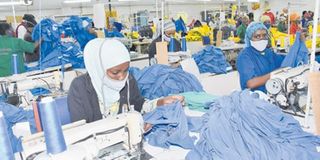Can Africa possibly take China’s manufacturing jobs?

Africa is witnessing a period of rapid population increase leading to a huge challenge of creating jobs for the young masses. While governments and development agencies prefer the usual solutions of ‘more skills and training’, ‘self-employment’, or even ‘poverty alleviation’, but evidence clearly shows that these don’t make the cut – to create hundreds of millions of jobs in the next few decades, robust strategies for mass jobs creation are needed.
Industrialisation is one of the traditional solutions for job creation. Unfortunately, since 1980s, Africa has generally deindustrialised – the average share of manufacturing in GDP remains less than half that of other developing nations. This means that only 5 percent of new job entrants have a chance of getting employment in the manufacturing industry.
This is unfortunate since industries are the greatest source of mass employment. When China increased its share of global manufacturing from 2 percent to 25 percent, 750 million people were lifted out of poverty. This is due to fact that for every 100 jobs created in a factory, 160 service or supporting jobs will follow. Therefore, from Europe to America, and Japan to China, manufacturing transformed all nations in which it was or is perversive because it promotes increased productivity and provides lasting ways of creation of wealth.
That said, the situation in Africa is changing. Africa’s industrial output has been increasing and is now on a trajectory to be doubled $1 trillion by 2030. The good thing is that the Chinese – those masters of modern industrial transformation from whom Africa can learn so much – are playing a huge part in this change as they invest in at least 150 new manufacturing ventures every year, up from two about two decades ago.
Many of these investors are looking for places to relocate their factories to as the labour pool in China shrinks, thanks to the antiquated one-child policy. Other factors include decreasing internal demand, increasing labour costs, and the shift from low-skill and labour-intensive manufacturing to high tech. With time, this will end up freeing up to 100 million jobs in China.
Is Africa positioned to capitalise on this opportunity and get a good portion of those jobs? Some experts have proposed that Africa will ultimately replace China as the next world’s manufacturing centre. This is one of the themes of Irene Yuan Sun’s book called The Next Factory of the World. It’s a tantalising idea, but there are reasons to curb our optimism still.
For a starter, China’s manufacturing juggernaut is not done yet. With a sixfold increase in industrial output in 15 or so years ago, who knows how China will reinvent itself to protect its strategic advantage? China has proved itself to be quite adept at strategic thinking and innovation, and smart money right now is with her.
Moreover, while indeed some 10 percent of Chinese factory owners consider relocation, most of them prefer the familiar South East Asian nations such as Vietnam, Thailand, Malaysia, Cambodia, and Indonesia than Africa. Sizable number of people in those nations are ethnically Chinese, and those nations are already proven as solid alternatives to Chinese factories, especially in light manufacturing industry for products such as toys, garments, footwear, and electronics assembly.
Finally, the cost of labour and the cost of doing business in Africa are relatively higher than those from competing nations. So, it may be too early to determine how competitive Africa will be as a manufacturing centre.
Nevertheless, Africa has many open opportunities that policy makers and investors can capitalise on. Its rapidly increasing population is at the top. To put this into perspective, in 2050 Nigeria will have a population that is bigger than that of the United States. Like most African nations, 80 percent of that growth will be happening in cities – and this will lead to rapid urbanisation: soon Africa will have over 100 cities with at least 1m people. This will create a huge internal demand for food, beverages, pharmaceuticals, clothes, footwear, energy and technology products, a sizable market that can be served by local manufacturers.
On the competitiveness side, there are some huge improvements too – investment in infrastructure in Africa has doubled to an annual $80 billion lately, near to $100 billion needed to close the infrastructure gap. With Ethiopia’s Grand Renaissance Dam now filling, Tanzania’s Julius Nyerere Hydropower Station taking shape, and similar projects across the continent, Africa is slowly addressing one of its biggest obstacles to industrialisation – availability, reliability, and cost of power.
Similarly, governance indicators appear to be improving in many nations. Nations such as Mauritius, Rwanda, and Botswana have made some great strides in world ‘easy of doing business’ rankings lately, thus making them more attractive for foreign direct investments, a major success factor in industrialisation today.
Industrialisation may be Africa’s last economic development frontier. If Africa can get only 5 percent of manufacturing investments moving out of China, that will lead to over 200 percent increase in Africa’s manufacturing capacity, creating millions of jobs. Capitalising on that window of opportunity before it closes is one of the biggest challenges that our policy makers face today.
_________________________________________
Charles Makakala is a Technology and Management Consultant based in Dar es Salaam




